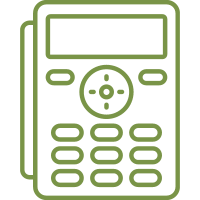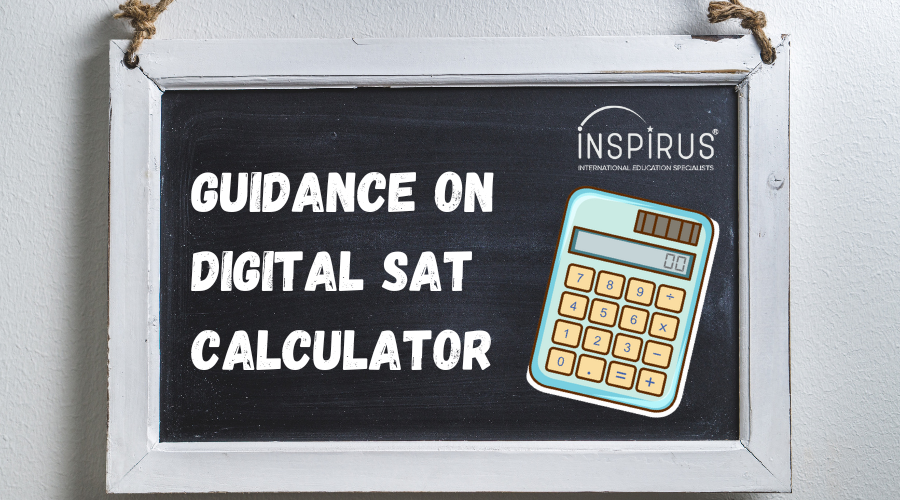Math in Digital SAT is divided into two modules, each module consists of 22 questions, which are to be solved in 35 minutes. Students may use their own approved calculator on test day or take advantage of the graphing calculator built directly into the testing application Bluebook. If you choose to bring your own calculator to use throughout the Math section, there’s more to it than making sure you’ve got a fresh set of batteries. The College Board officially recommends that you not use a four-function calculator. It allows the usage of all scientific calculators and most graphing calculators.

Four-function Calculators
A four-function calculator allows for only four basic calculations: addition, subtraction, multiplication, and division. This is the most common calculator, which we often see with shopkeepers and even at our homes for basic calculations.
Now, why are four-function calculators not recommended? These calculators don’t have the basic trigonometric operations, such as sin, cos, tan, etc. Thus, if you need to find sin (20) for a question, then the four-function calculator won’t help you. The four-function calculators don’t have even exponent calculations, which might be needed in the Digital SAT. So, even though students are allowed to use them, the College Board doesn’t recommend their usage.
Scientific Calculators
These calculators have all the functionality of the four-function calculators, along with trigonometric functions, exponents, roots, etc., which might be useful in the Digital SAT.
All scientific calculators are allowed in the SAT.
However, be mindful that though the Math section allows the use of calculators, all of these questions DO NOT need to be solved with a calculator. Most questions require fundamental knowledge of basic mathematical concepts and don’t need calculators at all. Only a few questions can be attempted by using just a calculator.


Graphing Calculators
The Digital SAT allows most graphing calculators. The detailed list is provided on the College Board website. But some of the common ones that are allowed and can be bought online are TI-84 plus, TI-89, Casio FX-CG50, TI-Inspire, Casio FX-9860, etc. Refer to the link – https://satsuite.collegeboard.org/digital/what-to-bring-do/calculator-policy – to know more about the list of approved calculators.
Now, which calculators should you prefer for the SAT?
We recommend students use the graphic in-built calculator on the Bluebook app. It consists of a wide range of applications. For practice, you can use the link https://www.desmos.com/calculator.
The only difference between scientific and graphing calculators is that graphing calculators also have the ability to graph functions, such as exponents, squares, roots, etc. So, a few questions in coordinate geometry dealing with graphs may be easier to attempt if you have a graphing calculator. But keep in mind, that a graphing calculator is not a prerequisite for solving any question. Even graph-based questions can be attempted manually; with a proper technique, they may be solved even faster than with the help of a graphing calculator.
It takes time to punch in all the inputs in a graphing calculator. Moreover, there are questions that deal with the interpretation of graphs, and they can’t be solved by a calculator at all. A student needs to have an in-depth knowledge of functions and graphs to solve those questions. So, having a graphing calculator is not a substitute for knowledge of coordinate geometry.
So, should you use a graphing calculator?
We would say that it depends on your comfort level.
Suppose, all your life, you have manually drawn graphs, and you are most comfortable with this method. Then, it makes sense to solve graph-based questions by drawing the graphs manually, as that process is most suitable for you. But if you extensively use graphing calculators in school to draw the graphs of functions, and this comes naturally to you, then the usage of a graphing calculator gives a great advantage in the test.
To repeat, a graphing calculator is not a substitute for knowledge of coordinate geometry. There will be many questions that cannot be solved with even a calculator, and you would need knowledge of coordinate geometry to attempt them.
Another aspect involved in choosing between a graphing or a scientific calculator can be the cost aspect of owning a graphing calculator. Most graphing calculators cost between Rs. 8000 and Rs. 10,000, while scientific calculators can be bought for even Rs. 500. So, if the cost is a constraint, a scientific calculator would be preferable to a graphing calculator. Nevertheless, the built-in graphic calculator on the Bluebook app is the best.
You must remember to carry your calculator. You can’t share one.
Good Luck for your SAT!


